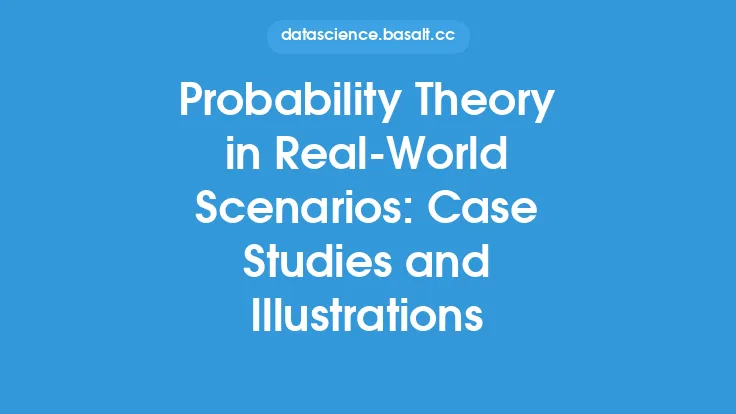Probability theory is a branch of mathematics that deals with the study of chance events and their likelihood of occurrence. It provides a mathematical framework for analyzing and modeling random phenomena, which is essential in various fields, including statistics, engineering, economics, and computer science. In this article, we will review the key concepts in probability theory, focusing on important terms and definitions that form the foundation of this field.
Introduction to Probability Concepts
Probability theory is based on a set of fundamental concepts, including probability measures, events, sample spaces, and random variables. A probability measure is a function that assigns a non-negative real number to each event in a sample space, representing the likelihood of the event occurring. The sample space is the set of all possible outcomes of a random experiment, and events are subsets of the sample space. Random variables, on the other hand, are functions that assign a numerical value to each outcome in the sample space.
Probability Axioms and Properties
The probability axioms, also known as the Kolmogorov axioms, are a set of rules that govern the behavior of probability measures. These axioms state that the probability of an event is always non-negative, the probability of the entire sample space is equal to 1, and the probability of the union of disjoint events is equal to the sum of their individual probabilities. Additionally, probability measures satisfy certain properties, such as countable additivity, which allows us to calculate the probability of complex events by breaking them down into simpler components.
Types of Probability
There are several types of probability, including classical probability, relative frequency probability, and subjective probability. Classical probability is based on the idea that the probability of an event is equal to the number of favorable outcomes divided by the total number of possible outcomes. Relative frequency probability, on the other hand, is based on the idea that the probability of an event is equal to the proportion of times the event occurs in a large number of trials. Subjective probability, also known as Bayesian probability, is based on personal beliefs and degrees of confidence.
Independence and Dependence
Two events are said to be independent if the occurrence or non-occurrence of one event does not affect the probability of the other event. In other words, the probability of both events occurring is equal to the product of their individual probabilities. On the other hand, two events are said to be dependent if the occurrence or non-occurrence of one event affects the probability of the other event. Dependence can be either positive or negative, depending on whether the occurrence of one event increases or decreases the probability of the other event.
Expectation and Variance
The expectation, also known as the expected value, of a random variable is a measure of its central tendency. It is calculated by summing the product of each possible outcome and its probability. The variance, on the other hand, is a measure of the spread or dispersion of a random variable. It is calculated by summing the squared differences between each possible outcome and the expected value, weighted by their probabilities. The standard deviation is the square root of the variance and provides a more intuitive measure of the spread.
Convergence of Random Variables
Convergence of random variables is an important concept in probability theory, as it allows us to study the behavior of sequences of random variables. There are several types of convergence, including convergence in probability, almost sure convergence, and convergence in distribution. Convergence in probability means that the probability of the difference between the sequence and the limit exceeding a certain value approaches zero as the sequence progresses. Almost sure convergence means that the sequence converges to the limit with probability 1. Convergence in distribution means that the distribution of the sequence converges to the distribution of the limit.
Limit Theorems
Limit theorems are a set of results that describe the behavior of sequences of random variables as the sequence progresses. The law of large numbers states that the average of a sequence of independent and identically distributed random variables converges to the expected value as the sequence progresses. The central limit theorem states that the distribution of the sum of a sequence of independent and identically distributed random variables converges to a normal distribution as the sequence progresses. These theorems provide a foundation for statistical inference and are widely used in many fields.
Probability Inequalities
Probability inequalities are a set of results that provide bounds on the probability of certain events. The Markov inequality states that the probability of a random variable exceeding a certain value is less than or equal to the expected value divided by that value. The Chebyshev inequality states that the probability of a random variable differing from the expected value by more than a certain amount is less than or equal to the variance divided by the square of that amount. These inequalities are useful in a variety of applications, including statistical inference and risk analysis.
Applications of Probability Theory
Probability theory has a wide range of applications in many fields, including statistics, engineering, economics, and computer science. In statistics, probability theory is used to develop statistical models and make inferences about populations based on sample data. In engineering, probability theory is used to design and optimize systems, such as communication networks and financial systems. In economics, probability theory is used to model economic systems and make predictions about future outcomes. In computer science, probability theory is used in machine learning and artificial intelligence to develop algorithms and models that can learn from data and make predictions.
Conclusion
In conclusion, probability theory is a rich and complex field that provides a mathematical framework for analyzing and modeling random phenomena. The key concepts in probability theory, including probability measures, events, sample spaces, and random variables, form the foundation of this field. Understanding these concepts, as well as the various types of probability, independence and dependence, expectation and variance, convergence of random variables, limit theorems, and probability inequalities, is essential for working in a variety of fields, including statistics, engineering, economics, and computer science. By mastering these concepts, researchers and practitioners can develop a deeper understanding of random phenomena and make more accurate predictions and decisions.





